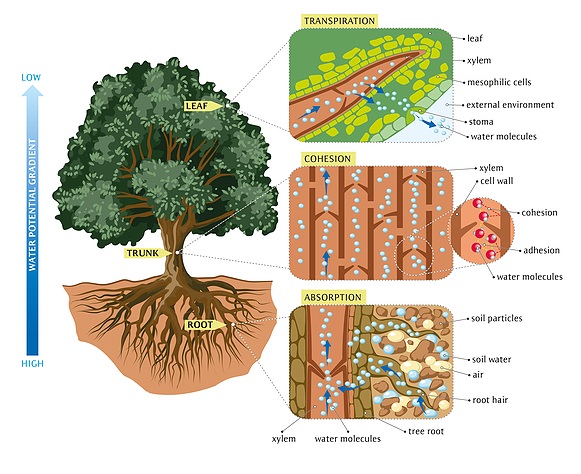Trees, with their silent whispers in the wind and stoic presence in the face of time, represent an enigma that stands out in our natural landscape. They are much more than just a collection of leaves or a fixture in your yard. Every part of a tree, from the complex root system underground to the smallest twigs that sway in the breeze, plays a unique and essential role in the tree’s lifespan and the broader environment.
In this in-depth guide, we’re peeling back the layers of arboreal anatomy for botanists, nature enthusiasts, and curious minds who want to appreciate the intricate design that allows trees to reign over the Earth with such grace. Understanding the inner workings of a tree isn’t just an academic fascination — it can transform how you care for your backyard giants and how you view the forests you roam.

Basic Tree Anatomy
Tree Root System
Beneath the surface, where many don’t think to look, tree roots form a complex network that sustains the living sentinel above. Roots are not just a structural support. They are the tree’s mouth, nose, and digestive system all rolled into one. They anchor the tree securely in the ground and absorb water and nutrients from the soil with precision that modern pipelines envy.
Common Types of Tree Roots:
Taproots: Round and sizable, they are the main support for some tree species like oaks and pines.
Fibrous Roots: A tangled mess of delicate roots are great soil stabilizers and nutrient absorbers, common in many shrubs and grasses.
Adventitious Roots: These special roots, which arise from unusual places like stems and leaves, provide additional support or serve as an anchor on rough terrain.
Tree Trunk and Bark
From the outside, the tree trunk is a protective layer of bark. Beneath the surface, it’s a thick fortress of wood, tough enough to withstand the elements and provide support for the leafy crown. Bark isn’t just tree skin — it’s a living, breathing armor that shields against pests, pathogens, and extreme weather. Its colors and textures are as varied as the tree species, each with their own healing, insulating, or camouflaging properties. Slicing through the trunk reveals a story written in concentric circles — the growth rings. They chart the successes and struggles of each past year, providing a remarkably accurate biographical sketch of the tree’s evolving ecosystem.
Branches and Twigs
The framework of a tree extends itself in almighty branches and delicate twigs. How a tree extends its reach can tell us a lot about its species and its history. Branching isn’t random; it’s a response to light, competition, and genetic predisposition. Twigs are the explorers, seeking out the best spaces for leaves to capture sunlight and fulfill the tree’s photosynthetic dream.
Pruning for Health and Aesthetics
Understanding how trees grow can guide us in the art of pruning. Done right, it improves airflow, encourages healthy new growth, and can even save a tree from toppling over in a storm it otherwise might not have survived.
Leaves
Leaves are a tree’s green machines, transforming sunlight into food and oxygen. Leaves come in all shapes and sizes, from the spindly pines to the broad oaks. Each form speaks to the tree’s unique evolutionary path and ecological niche. A leaf’s anatomy is a marvel of natural architecture, optimized for maximum surface area and exposure to the sun. Chlorophyll is the star of the leafy stage, absorbing sunlight and giving leaves their green hue. Discover how this molecule is the bridge between the tree and the sun that sustains life across the globe.
Flowers and Fruits
The reproductive cycle of trees is a wondrous spectacle, often missed in the serene grandeur of their presence. A tree’s ultimate goal is to pass on its heritage. Many trees rely on wind, insects, birds, and even mammals to move pollen from one flower to another. It’s a cooperative effort that encapsulates the interconnectedness of nature. Fruits are nature’s packaging for seeds, often delicious and colorful invitations for creatures to help in the tree’s grand seed dispersal plan.
Conclusion
Trees are more than the sum of their parts. They are complex, living organisms that warrant respect and understanding. By appreciating the intricate details of a tree’s anatomy, we gain a deeper connection to the natural world and the responsibility to preserve it for future generations. As you journey through the woods or pause to feel the rough embrace of a tree’s bark, remember the complex life happening in every fiber. And when you return home, adorned with leaves and awe, let that knowledge inspire the care you give to your own arboreal companions.
Are you in need of expert tree service within the Indy areas? Look no further than Complete Tree Care! We specialize in residential and commercial tree services in Indianapolis, as well as storm damage. Contact us today at 317-783-2518 for a quote!
Related Posts:
The Essential Guide to Tree Inspections
Deciduous vs Coniferous: Understanding the Difference
Hardiness Zone facts for Trees, Flowers, and Plants

